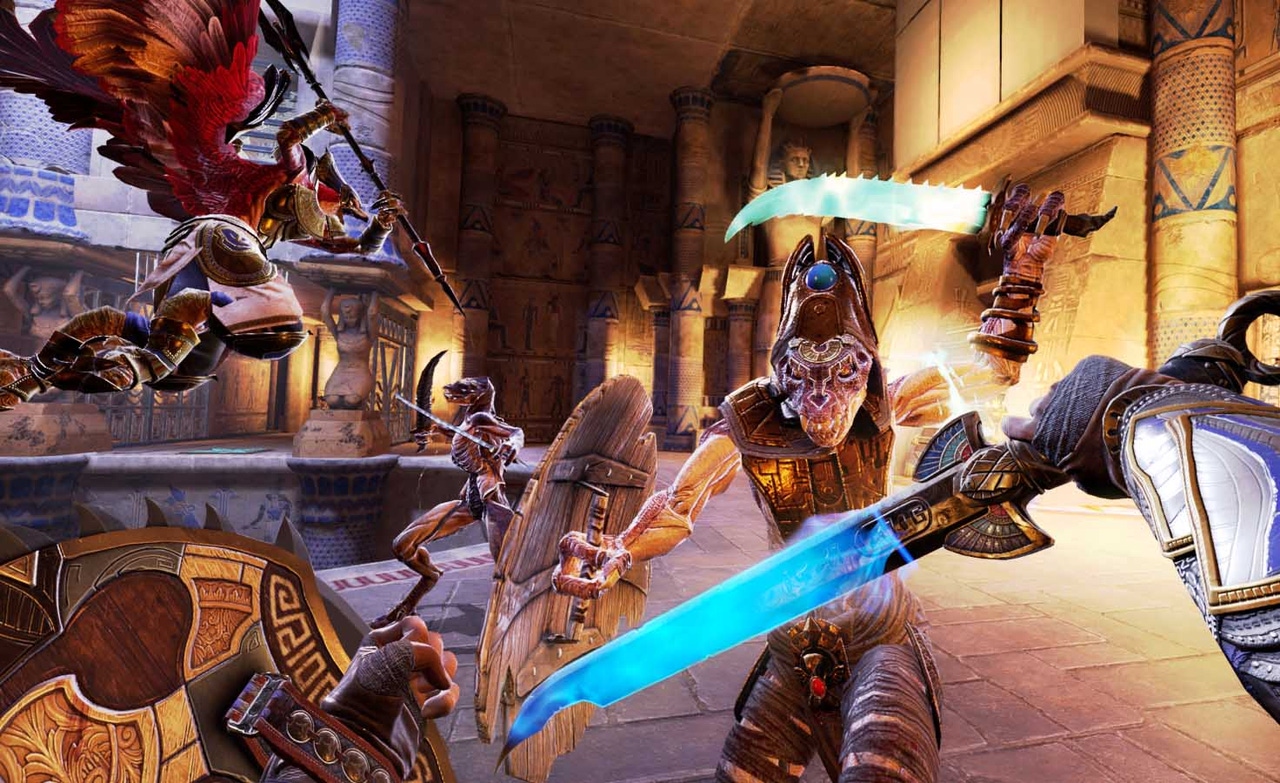Trending
Opinion: How will Project 2025 impact game developers?
The Heritage Foundation's manifesto for the possible next administration could do great harm to many, including large portions of the game development community.
When someone asks you if you're a god, you say yes.

Sanzaru Games' Meta Quest game Asgard's Wrath stood out in a sea of first-person virtual reality combat games by mixing first-person hack & slash action with a host of powers inspired by Norse mythology. For Asgard's Wrath 2, the Meta-owned game studio sent its Norse heroes south, and set out to experiment with new mechanics that sell the power of godhood.
One such mechanic is a new feature called "Godscale perspective." It's a toggle where players switch from the first-person perspective of a warrior on the battlefield to the top-down perspective of a god hovering over the landscape. Objects become relatively smaller in this mode, meaning that a wall that blocked your progress is now a piece of wood you can pick up and move around. It brings the spirit of old "god games" like Black & White to the VR era.
Senior game producer Mari Kyle of Oculus Studios (Sanzaru Games' parent company) told Game Developer that developing Godscale was an ambitious goal from a technical and design perspective—even though giving players the point-of-view of a god feels great, the free agency they have to move around the space means that there's no room for error on a game running on the Meta Quest's hardware.
Here are some interesting lessons from making the perspective shift work in VR.
Given that Asgard's Wrath 2 is set in a massive open-world inspired by ancient Egypt (itself an impressive technical achievement given how early days it still is for VR), letting players ascend to Godscale perspective anywhere could take the fun out of the game. If you can escape from any problem by just floating up to the sky and dropping rocks on enemies, the game might feel mythological, but it would put a damper on the first-person combat.

That's why Kyle said the team made the decision to confine Godscale perspective to a series of "Godscale arenas" filled with challenging traversal puzzles. Even in a confined space, the team still had to account for player agency. "We can't control when the players will use it, where they're going to use it from, or where they're going to move to while they're doing it," she said. So that means everywhere in the chamber has to look "beautiful," and moving to every position in the chamber means players won't get stuck.
Puzzles in these spaces are designed around moving the player's mortal avatar from the beginning to the end of a level, meaning the player has to open some traversal paths from their perspective on the ground, and ascend to Godscale to move objects around (like the hull of a rotting ship, for instance) to create other paths. If the player picks up a portion of a ship's hull, that means the hull needs to be mapped and rendered on all sides.
Shifting between perspectives creates an interesting design challenge: how do you make the power of moving objects not feel "cheap," so that ascending to the POV of a God actually feels notable? Kyle explained that the solution here was to tie moving objects in Godscale to a resource. Players harvest "mortal energy" from enemies, and then spend that energy to move objects.
Objects that are "heavier" can then cost more power, helping still create the illusion of exertion that makes VR feel as close to a real interaction with an object.
Picking up traversal objects and placing them in the environment is a mechanic greatly informed by designing the Quest's hand controllers. Kyle said that Sanzaru wants players to be able to make as minute adjustments as possible in Godscale—because even a slight change in position could have big implications while playing as a mortal. She described a series of grappling hook points that are the foundation of a puzzle later in the game.
When players use these grapple points, they're sent flying in a direction based on where the grapple point is facing. So the difference of a few degrees in god mode could send the player flying in a direction they didn't expect. Part of the challenge is moving the grapple point so it's placed in just the spot needed to clear a jump.
Using perspective as an inspiration for design ideas is especially potent in virtual reality. Immortality director Sam Barlow noted in a recent chat with us that building challenges based on where players position the camera is still an under-explored element of game design—and the potential of "witnessing" the world through a god's eyes may be good inspiration for other VR developers too.
Read more about:
FeaturesYou May Also Like